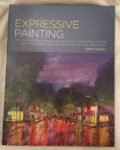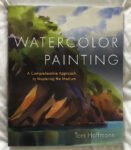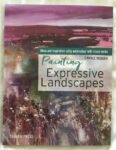My birthday's coming up and I have loads of new art instruction books to look…

Painting And Understanding Abstract Art, John Lowry – Book Review
Time for another book review and today it’s this one by John Lowry on painting abstracts. It’s a 160 page paperback by Crowood.
I’m not going to talk much about the chapter structure of this book as most of it felt like one long story and its division into chapters didn’t help or hinder this for me. There were three threads running through the book: a wishy washy one on what art is, a history of abstract art and 56 exercises for the reader. I’ll talk through those threads separately rather than doing my usual thing and talking things through chapter by chapter.
Except that there was one chapter that had a standalone feel to it, and that was was the 30 page chapter in the middle on colour theory. Most of it went over all the usual stuff about colour having three dimensions (hue, value, saturation) but with John using different words for these. There was some interesting stuff I’d not seen before, though, on analogous colour schemes where, if you’re going to mix them together, there are some important considerations around which colour should be in the centre of the arc that you’re taking from the colour wheel. I won’t spill the beans here. There was also (just like in the rest of the book) some history and there were some exercises, so this chapter did still fit into the overriding narrative.
So, the three threads. There was the wishy washy stuff about what is art and what’s abstract art. An interesting read, and something that this book needed, but not of much use to me. Although I did like John’s assertion that painting abstracts is more about the thinking than the doing.
Then there’s the history. Lots of interesting background on different artists and art movements. It’s nigh on impossible for books like this to get permission to reprint old paintings, so you might want to keep the iPad close to hand to see some of what’s being discussed. There are some timelines in there too and it’s interesting that the golden ages of jazz and abstraction were concurrent. Surely not an accident.
And then there are the exercises. Oh boy. This book is very different to the one I have by Rolina Van Vliet. With Rolina’s exercises I often didn’t know where to start. I’d be told to come up with a pleasing composition of shapes that I could paint with big value contrasts (say). But how do I come up with these shapes? That’s the hardest bit. And that’s where John steals the show. In all the exercises he tells us what sort of shapes to use or where to find ideas. The very first exercise is about slicing a cabbage in half and drawing the shapes that you see in the cross section. As an artist you’re going to eventually have to start coming up with ideas of your own but the best way to learn is to start with the teacher giving you the ideas. And did I say there were 56 exercises in the book? There’s no shortage of inspiration here and most, if not all, of them are illustrated with paintings or preparatory sketches for paintings that would work. And those exercises are so varied. We’re not looking at a single style of painting done 56 different ways. We’re looking at a huge variety of styles (even if John is the artist for most of them).
I like this book. I really like it. This is a book on painting abstracts that starts in the right place, not just giving us exercises that use the ideas being taught (like in other books) but that also helps get us started on those exercises. And by looking at or attempting all those exercises, we actually learn how to get started. This one smacks the opposition out of the park and is getting five palettes.
🎨🎨🎨🎨🎨
You can find this book and more reviews of it at Amazon UK here. As an Amazon Associate, I earn commission from qualifying purchases but this costs absolutely nothing extra to you.








Leave a Reply